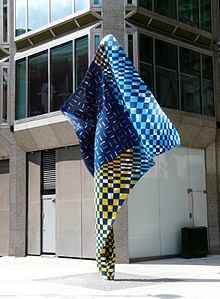Dutch Wax
Dutch Wax (also known as Wax Hollandais) are cotton fabrics that are printed in the Netherlands and have a colorful pattern on both sides . Careful market research , design development , the firmness of the colors and the color design and a long tradition lead to the highest possible prices on the African market. Many consider the patterns and colors of the fabrics designed in the Netherlands to be authentic African. In many parts of West Africa and other parts of the African continent, the patterned fabrics have become a distinctive part of African culture and identity . Original Dutch Wax has been produced by the Vlisco company for generations.
History
The wax print process was originally discovered by the Dutch when they copied the patterns of Indonesian batik fabrics and produced them industrially as textile prints in order to market the patterned cotton fabrics in what was then the colony of Java . This attempt failed because the Indonesians preferred their own traditional handicraft to the mass product.
The African market
There are three reasons the fabrics likely came to Africa in the 19th century .
- With freighters on the trade routes of the Dutch East India Company to Java Indonesia, the Dutch traders discovered a market on the West African Gold Coast , today Ghana . At the port of call in Elmina, there was great demand for the colorfully patterned fabrics. For the purpose of market research, the Dutch company Van Vlissingen & Co. (now Vlisco) sent young men via the port of Elmina to the West African coast to get in touch with women living there and thus to research the tastes and requirements of customers more closely.
- Black Dutch people were recruited in Accra , Axim and Elmina to serve in the Koninklijk Nederlandsch-Indisch Leger (KNIL) . When they returned home, these soldiers brought batik from Java with them and prepared the ground for the demand for Dutch Wax .
- The Ashanti Empire operated in the 18th and 19th centuries on a large scale slave trade . With the gradual abolition of the slave trade which was based on the African continent intensified missionary one. Through the contacts of Dutch traders with mission stations on the former Gold Coast, they received detailed, reliable and thus valuable information about the clothing behavior and the preferences for certain fabric samples of the Gold Coast inhabitants. In addition, they were probably able to use the mission stations to obtain opinions from market women who were active in the wax print trade and who knew the buying behavior . The missionaries also had an interest in introducing a dress code , as they wanted to teach Africans to cover their nakedness and to obey the laws of morality .
technology
In order to be able to produce more efficiently, a technique was sought with which the liquid wax can be applied by machine. The fabric must be completely penetrated so that the fabric is protected from color on both sides and the pattern is visible in the same quality on both the front and the back. The Belgian JBT Prévinaire perfected the Perrotine (a textile printing machine that was invented by the French Luois-Jerome Perrot in 1835) into a wax printing machine and renamed it La Javanaise . The printing process of the Perrotine was based on the technology of wood printing stamps, as they were also used in manual production.
The application technique used today is based on a double-roller technique and the wax is replaced by resin or paste.
Manufacturer
- The Helmond- based company Van Vlissingen & Co (now Vlisco) in the Netherlands
- Calico Printers Association (CPA) in Manchester
- Prévinaire, Haarlemse Katoen Maatschappij (HKM)
- Uniwax in Ivory Coast , former subsidiary of Vlisco, since 2010 Actis
- Ghana Texile Printing (GTP) in Ghana, Actis
Artistic material
Yinka Shonibare uses Dutch Wax as her artistic material . He is a British - Nigerian artist born in London in 1962 who has designed groups of figures wearing Victorian clothing made from Dutch Wax .
literature
- Robin van Koert. Dutch wax design technology from Helmond to West Africa: Uniwax and GTP in post-colonial Cote d'Ivoire and Ghana. Eindhoven: Stichting Afrikaanse Dutch Wax, 2007 ISBN 9081212818
Individual evidence
- ↑ Robb Young: The New York Times 11/2012 Africa's Fabric Is Dutch accessed on August 25, 2013 (English)
- ↑ Gabriele Gerlich: Waxprints in the Socio-Cultural Context Ghana's Institute for Ethnology and African Studies ( Memento of the original from October 4, 2013 in the Internet Archive ) Info: The archive link was inserted automatically and has not yet been checked. Please check the original and archive link according to the instructions and then remove this notice. (PDF; 2.3 MB) accessed on August 25, 2013 (English)
- ↑ What You Always Wanted to Know About Wax Print Fabric ( Memento of the original from August 8, 2013 in the Internet Archive ) Info: The archive link was inserted automatically and has not yet been checked. Please check the original and archive link according to the instructions and then remove this notice. accessed on August 25, 2013
- ↑ Press release: Actis takes over Vlisco Group ( page no longer available , search in web archives ) Info: The link was automatically marked as defective. Please check the link according to the instructions and then remove this notice. Retrieved September 14, 2013
- ↑ Saharan vibe Yinka Shonibare - the African textile artist accessed on August 25, 2013 (English)
